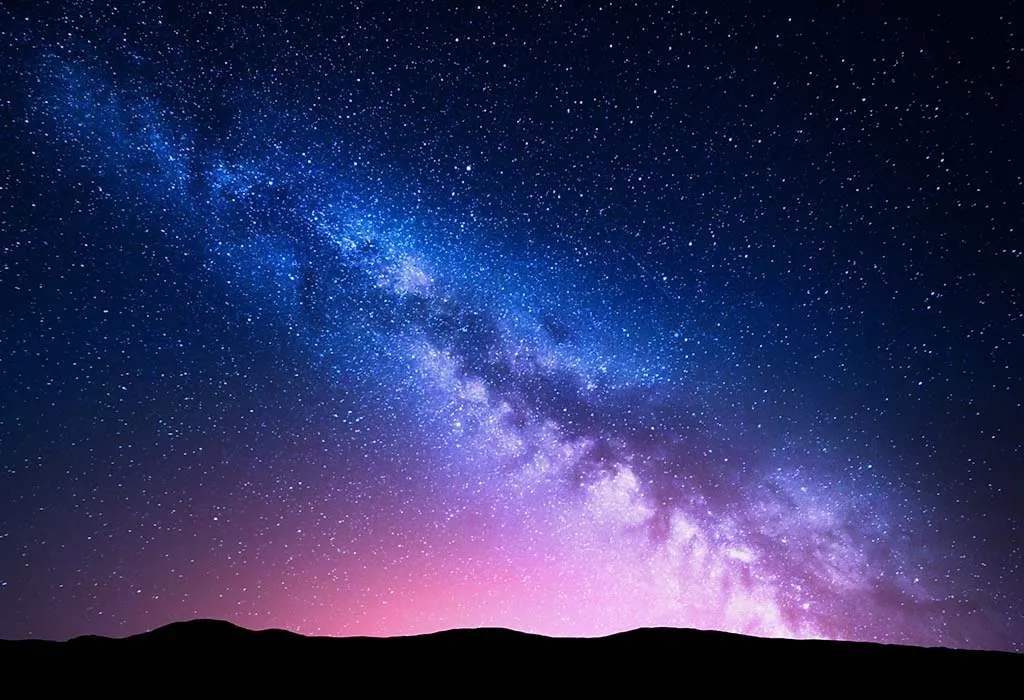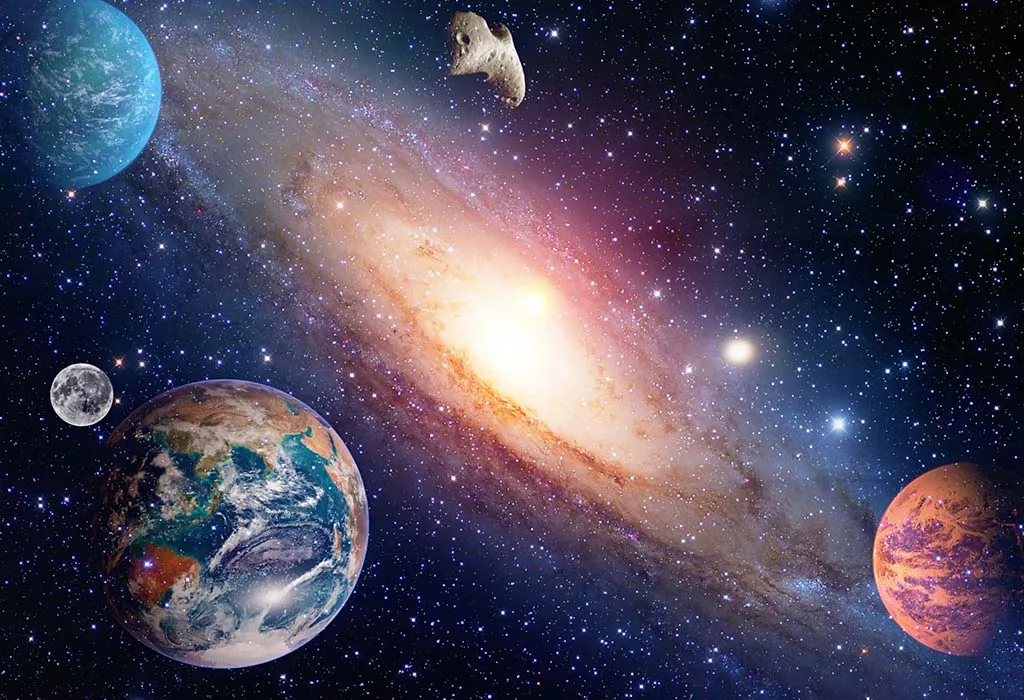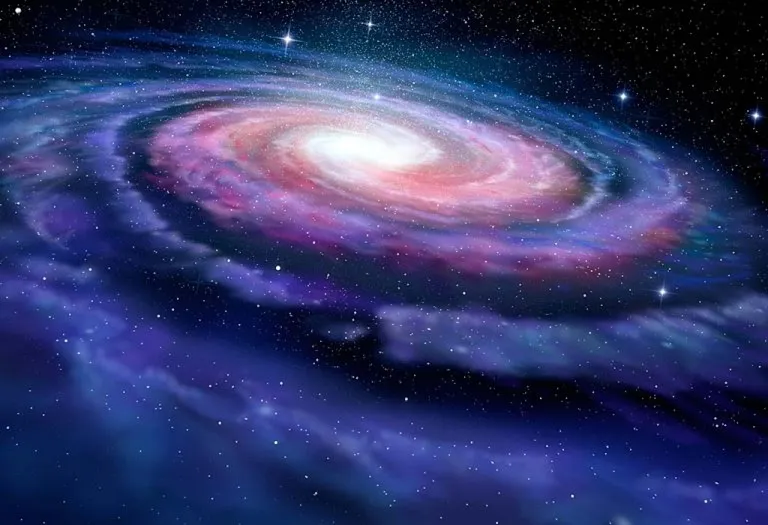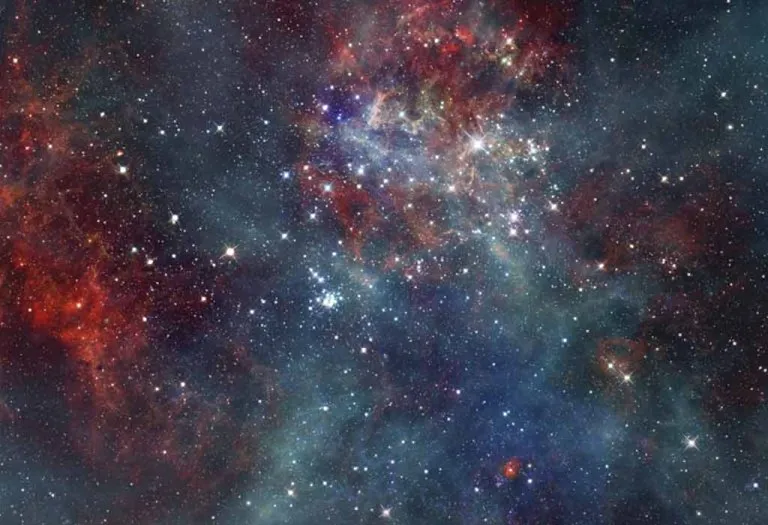Facts About the Milky Way for Kids
The Milky Way, or ‘Akash Ganga’ as it is known in India, is a band of stars that appears as a hazy glow in the night sky. But what’s fascinating is that this ribbon of stars is actually the galaxy we live in. Yes, we live in the Milky Way galaxy! Did you know? The Milky Way Galaxy is the only galaxy in the universe with a planet where life has evolved and continues to exist. Kids are awestruck by the magnificence of Milky Way galaxy facts and always wonder what it is made of, how it started, and more. If you are ready to boggle your mind with the astonishing facts about our favourite galaxy, keep reading for the interesting facts about our Milky Way.
What Is the Milky Way?
A galaxy is a collection of trillions of stars and other forms of matter held in one place by the force of gravity. There are trillions of galaxies in the universe, and the Milky Way is one of them. The Milky Way galaxy is also our home; it’s where the Sun and the solar system are located. The Milky Way galaxy is a type of spiral galaxy with over 400 billion stars, as well as dust and gas, all arranged in disk components and surrounded by halo (1).
15 Interesting Facts About the Milky Way Children Should Know
There are many things we should know about the galaxy that we live in. Here are the most interesting and fun facts about the Milky Way galaxy your kid will love to know:
1. The Milky Way Has Ancient Mythical Origins
The ancient Greeks had a story about the origin of this band of stars. Once, the Goddess Hera was nursing Hercules when he was asleep. When she pulled herself away, the milk from her breast spilt across the heaven, creating the Milky Way. Nobody knows whether this is true or not.
2. The Milky Way Has Billions of Stars and Planets
If you go out at night, there will roughly be around 4500 stars you can see with just your eyes. Astronomers, however, have a much more sophisticated way to find out how many stars are there in our galaxy. So, if you’re wondering how many stars are present in the Milky Way, the estimates range between 100 and 400 billion stars! Another fun fact is that there are way more stars in the observable universe than there are grains of sand on all the oceans of the world combined.
3. The Milky Way Is Enormous in Size
The diameter of the Milky Way is estimated to be about 100,000 light years. One light year is defined as the distance travelled by light in one year travelling at the speed of 300,000 kilometres per second. Therefore, travelling at the speed of light would take 100,000 years to go from one end of the galaxy to the other (2).
4. The Milky Way Is a Spiral Galaxy
The Milky Way’s shape is that of a spiral; it looks like a disc from the top with spiralling arms winding out from its centre. There are different types of galaxies in the universe. The three main types are spiral, elliptical and irregular galaxies.
5. There Is a Black Hole at the Centre of the Milky Way
If everything is going around it, then there must be something massive at the centre of the Milky Way (3). Like the drain in the centre of a sink into which water flows down, there’s an enormous black hole at the centre of the Milky Way with a mass that is four million times that of the sun.

6. The Milky Way Is a Part of the ‘Local Group’ of Galaxies
The Milky Way is just a part of an enormous cluster of galaxies called the Local Group. It contains more than 50 galaxies and is about the size of 10 million light-years across. According to the Lowell Observatory, Andromeda is the largest member of the Local Group (4). Some of our closest neighbouring galaxies are the Andromeda Galaxy and the Triangulum Galaxy, which are visible to the naked eye. NASA says that Andromeda is so bright and near to our galaxy that it is one of only ten galaxies that can be seen from our planet with the naked eye (5).
7. The Milky Way Will Collide With the Andromeda Galaxy One Day
Our galaxy is moving gradually on a collision course with the Andromeda at a speed of 400,000 km/h. But it’s not of concern at the moment as it will happen after 4 billion years. Since both galaxies are almost of the same size, the outcome of the collision is uncertain.
8. There Could Be Millions of Planets in the Milky Way
Studies of stars through telescopes such as the Kepler telescope have revealed that most stars have planets going around them. When you consider that the galaxy contains 100-400 billion stars, it’s possible that there are millions of planets in the Milky Way Galaxy. Whether they can support life is a different question altogether.
9. Our Solar System Is Very Far Away From the Centre of the Milky Way
Our solar system lies about 30,000 lightyears away from the centre of the Milky Way and about 20 light-years above the plane of the galaxy.
10. The Milky Way Is Surrounded by a Dark Halo
Our galaxy is in between a massive lump of dark matter that far surpasses it in mass and size. Dark matter’s effect on galaxies has been known since the 1960s.

11. The Milky Way Is Surrounded by Ancient Stars
The oldest stars in the galaxy are concentrated in groups called Globular Star Clusters. There are about 150 of these globular clusters orbiting the Milky Way, and they can be as old as 12.7 billion years!
12. The Earth Is Only 18 Galactic Years Old
Since its formation, the Earth has orbited around the entire Milky Way only about 18 times. Our solar system goes around the galaxy once every 250 million years.
13. There Could Be Thousands of Solar Systems in the Milky Way
If there are planets around stars, then there should be solar systems, and if you’re wondering how many solar systems are in the Milky Way galaxy, so far, about 500 have been discovered. The number could, however, be in the millions as well.
14. Our Solar System Is Minuscule in Size As Compared to the Milky Way
If the whole of the Milky Way is shrunk to the size of 100 m, the size of our solar system would be no bigger than a grain of sand 1 mm in size.
15. The Oldest Star in the Milky Way is Almost As Old As the Universe Itself
HD 140283, also known as the Methuselah star, is one of the oldest known stars in our galaxy. The star is at least 13.6 billion years old, while the age of the universe is estimated to be around 13.8 billion years.
FAQs
1. What is the name of the galaxy human beings live in?
Human beings live on the planet Earth, which is in the Milky Way galaxy.
2. How long does it take for the sun to travel around the Milky Way galaxy?
According to the National Aeronautics and Space Administration, the Sun is located roughly 24,000 light years from the centre of the Milky Way galaxy (6). It is estimated that it takes about 220 million years for the sun to travel around the Milky Way just once at a speed of about 500,000 miles per hour.
3. Is Andromeda galaxy bigger than the Milky Way galaxy?
Yes, the Andromeda galaxy is evidently larger than the Milky Way galaxy, which is 100,000 light-years wide, whereas the Andromeda galaxy spans approximately 220,000 light-years.
4. What is the largest galaxy in the universe?
Alcyoneus is the largest known galaxy in the universe. It is a giant radio galaxy containing lobes, spanning roughly 16.28 million light-years.
We hope you loved our fantastic collection of facts on the Milky Way galaxy. Every information about the Milky Way galaxy – from its size to the number of stars and the forces that shape it – is astounding. The more we learn about our own galaxy, the more we understand where we stand in the grand scheme of things.
References/Resources:
1. University of California, San Diego Center for Astrophysics & Space Sciences – The Milky Way Galaxy
2. European Space Agency – The Milky Way
3. University of Maine – 10 Facts about the Milky Way
4. Lowell Observatory – Views From Mars Hill: Andromeda Galaxy
5. NASA – The Galaxy Next Door
Also Read:
Facts of Sun for Children
Incredible Facts about Space for Kids
Amazing Facts of Planet Earth for Kids
Spellbinding Facts About Sun for Children
Was This Article Helpful?
Parenting is a huge responsibility, for you as a caregiver, but also for us as a parenting content platform. We understand that and take our responsibility of creating credible content seriously. FirstCry Parenting articles are written and published only after extensive research using factually sound references to deliver quality content that is accurate, validated by experts, and completely reliable. To understand how we go about creating content that is credible, read our editorial policy here.























